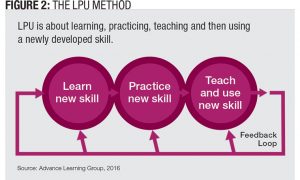 Leadership development is failing. The leadership pipeline is low, and executive search firms are growing thanks to a pronounced need for talented leaders at all levels. A seismic shift is needed to bring about new thinking in how best to develop future leaders. Yet we don’t have time to wait for this shift; we need to develop leaders now.
Leadership development is failing. The leadership pipeline is low, and executive search firms are growing thanks to a pronounced need for talented leaders at all levels. A seismic shift is needed to bring about new thinking in how best to develop future leaders. Yet we don’t have time to wait for this shift; we need to develop leaders now.
Part of the problem is that too often leadership has been a solo sport. Success stories abound, rife with “I’m going as far and as high as I can” thinking, with an emphasis on the “I.” Despite myriad books and public accolades about great leaders, nearly every truly great leader will credit others they worked with for their success. Even fictional heroes such as Harry Potter had help. No one rises on their own, they do so with collaboration and support from their colleagues and team.
In their book “Learning Leadership: The Five Fundamentals of Becoming an Exemplary Leader,” James M. Kouzes and Barry Z. Posner write that “no one ever made anything extraordinary happen alone.” The number of learning activities that involve teamwork and collaboration attest to the fact that learning how to build and manage teams is an important part of leadership.
In Ram Charan’s book “The Leadership Pipeline: How to Build the Leadership Powered Company,” he talks about six leadership passages leaders go through as they progress through the leadership ranks. Each level requires a different set of skills than the one before, and development to ensure leaders learn the right skills at each level. Truly, there is more than one way to grow leaders.
Learning leaders need to:
- Ensure that learning fits the organization’s culture and goals. No one learning platform or learning style fits all.
- Provide the systems so learning does not occur in a vacuum but is fully supported on the job and within the leader’s team.
Realize that up is not the only direction on the leadership ladder, and in today’s VUCA — volatile, uncertain, complex and agile — world, up may not even be the best way. The ladder should be turned sideways so that leadership growth occurs laterally or even spirals as leaders learn about a new function or department. And bring in leaders where their skills and talents are — individual contributor, front-line manager, mid-level manager/director and executive — and allow them to remain successful longer at these levels.
Connect Leadership Development to Company Culture
There are many options available for leadership development, from online to onsite, from executive education to experiential activities. But whatever learning delivery method wins, leadership development programs need to fit the culture, style and goals for both the organization and the leaders receiving the training. Too often, they simply don’t. Customization is minimal — putting the company name on the program or perhaps adding an industry-specific case study.
To truly fit the organization, leadership development programs must be linked to three organizational facets: initiatives, key goals and strategy and culture. It’s long been said that culture eats strategy for lunch. If leadership development acknowledged this, tied its activities to both culture and strategy, and integrated with key initiatives, it would create a program that fits the organization like the proverbial glove.
The Bill and Melinda Gates Foundation has successfully integrated both culture and learning. For example, the company has a monthly leadership development cadre, which includes guided discussion by a coach on a specific subject. This is followed by self-identified assignments where leaders practice a skill before the next meeting, then come back and report results.
This reminds leaders that they are the “culture carriers” for the foundation, and the flipped discussion helps drive culture and leadership development. Senior leaders also engage in action learning with the CEO as project sponsor. “These 80 leaders explore both culture and leadership while doing real work and helping to build the culture we desire,” said Kara Laverde, the foundation’s manager for leadership and learning.
- Rajkumar, former CLO at Dr. Reddy’s Laboratories, agreed that customizing culture-related leadership development offerings is important, as is context for learning when developing leaders. “While cross-fertilization of leadership practices is most welcome, there are industry-specific nuances that need to be learned by future leaders,” he said.
Figure 1 shows the interconnection between an organizational initiative, culture and its goals and strategy. To be most effective, leadership development must be linked to all three. Leadership development then becomes integrated into the organization rather than a one-off learning event.
Don’t Discount Different Leadership Development Methods
Usually, to learn how to be a leader, high potentials work with other leaders. Learning methods include self-study, classroom, virtual and on-the-job, and they take place in many ways including onsite, offsite, online and mobile because individuals learn differently. Incorporating different learning methods ensures that every leader can learn in a way that works best for them.
But there’s a problem. Leadership actually happens in moments spent with the leader’s team, business unit and direct reports. But high potentials can’t learn leadership with peers and then go back to their units, departments, organizations and boards with just an action plan and a commitment form. How often do those commitments last when they’re hit with crises, emergencies or just a backlog of work? They disappear in a flash.
Terrence Donahue, corporate director for learning in the Charles F. Knight Learning Center at Emerson, a global manufacturing and technology company, said that when managers return from training, their employees have new, higher expectations for them. “They want their managers to implement their newly-gained skills and be more effective in their role,” he said.
For instance, to develop mid-level leaders at Emerson, which has more than 235 locations in 140 countries, Donahue said the challenge was to establish both a company and a country culture for them. This desire ultimately spawned the Leading at Emerson 2.0 program. Another part of the challenge was to design a leadership development program that was transformational, not just informational, and that would turn a local common practice into a best practice, and balance relationships with results.
A different kind of learning system can help to mitigate the gap between a leader’s desire to learn and the realities of a busy executive’s life. LPU is such a system. It stands for learn, practice, teach and use, and it acts as a kind of central processing unit for learning (see Figure 2). Here’s how it works. Leaders:
 Learn the skill or knowledge in the style that works best for them.
Learn the skill or knowledge in the style that works best for them.- Practice either in the classroom, through action learning, or via another way to transfer learning with coaching support.
- Teach and use this new skill with their team.
Teaching and using the skill with the team is key. This ensures that direct reports hear and understand what the leader has learned, and leaders develop the skill better because teaching a skill to others is one of the best ways to reinforce a newly learned concept.
The LPU method helps ensure that direct reports are not on the outside looking in; they are actively involved in learning, implementation and use of new leadership skills. This increases engagement levels. “Employees should have expectations of their boss when they attend training,” Donahue said.
Infosys BPO also has a great system for developing front-line leaders. According to Amit Nagpal, former head of capability planning and development for the global outsourcing firm, in order to build a pipeline of ready-to-deploy front-line leaders, the company collaborated with a leading business school and over 16 months used a combination of classroom and action learning projects. As a result, some 60 percent of SMEs became front-line leaders with high employee satisfaction and retention. Senior leaders played a key role in this effort as facilitators, providing budget and resources, review and direction, success through scalability, recognition, and a best practice sharing mechanism.
Explore Horizontal Leadership Growth Options
In a traditional workplace, the only way to grow as a leader is to move up. Yet, that can mean fewer opportunities as high potential leaders have only a few options: become the chosen successor; have organizational knowledge, skills and abilities go unused; or find a new place to work and lead.
There’s a better way, one that retains valued leaders. In the aforementioned book, Charan identifies different skills needed at each organizational level. Why not make it possible for someone to lead where they lead best? Why not encourage talented individuals to become a master at one level, and then take that knowledge and leadership skill to other units within the organization?
It’s an interesting and valuable perspective on talent mobility as a development tool. That individual gets cross-trained in other areas of the organization to enhance their knowledge and skills. And the new team gets knowledge of a department or function they may not have worked in.
Further, even if someone is good at being a front-line leader or senior manager, there’s no guarantee that he or she will be great at the next level. A spiraling leadership career path may be a better way to broaden the leader’s knowledge through various functions and still ensure the organization benefits from the development exercise.
Flatter organizations may even have a wider compensation band to provide salary increases for moving to a new area. The spiral also can slowly rise, allowing leaders to share their knowledge and skills through different departments in the organization, and then perhaps move up one level.
To combat the leadership crisis, learning leaders have to ensure leadership development fits an organization’s culture, goals, strategy and initiatives. The LPU method — learn, practice, teach and use — is one way to involve the leader’s direct reports in development, which is important because leadership is not an individual activity.
Then, create spiral or horizontal career paths that extend the expertise and skills at the level where leaders are most successful. And when they appear ready to move up a level, do so with preparation and action learning. These thoughtful activities will help leaders become the guiding force behind an organization’s future success.
Howard Prager is president of Advance Learning Group. Comment below, or email editor@CLOmedia.com.















